Orthodontics is a specialized branch of dentistry focused on correcting misaligned teeth and jaws. It involves the diagnosis, prevention, and treatment of dental and facial irregularities. Orthodontists use a variety of appliances, such as braces and clear aligners, to guide teeth into their proper position. The goal is not only to improve the appearance of your smile but also to enhance the overall function of your bite, making it easier to speak, chew, and maintain good oral hygiene.
Why Orthodontic Treatment Matters
Orthodontic treatment is often essential for both functional and aesthetic reasons. Misaligned teeth or jaws can lead to a range of issues, including:
- Difficulty with Biting, Chewing, and Speaking: Poorly aligned teeth can make eating uncomfortable and may even affect speech.
- Tooth Decay and Gum Disease: Crowded teeth can be harder to clean, increasing the risk of cavities and gum disease.
- Jaw Pain and Headaches: An improper bite can place extra strain on your jaw muscles, leading to discomfort, headaches, or even jaw joint disorders (TMD).
- Aesthetics and Confidence: A straight, healthy smile can boost self-esteem and improve your overall appearance.
Orthodontic treatment addresses these concerns by correcting bite issues, improving oral health, and enhancing your smile.
How Orthodontic Treatment Works
Orthodontic treatment works by applying gentle, consistent pressure to the teeth over time, gradually moving them into the desired position.
- Consultation and Planning: Your orthodontist will first conduct a thorough examination, which may include X-rays, photographs, and impressions of your teeth. From there, he will design a personalized treatment plan tailored to your needs and goals.
- Appliances: Depending on your case, your orthodontist may recommend traditional braces, clear aligners, or other specialized appliances to guide your teeth into proper position.
- Regular Adjustments: You'll visit our office every four to twelve weeks for checkups and adjustments, ensuring steady progress toward your ideal smile.
- Retention: After your active treatment phase, you'll wear a retainer to keep your teeth in their new positions and prevent shifting over time.
Tips for a Successful Orthodontic Journey
Your cooperation and care play a big role in achieving the best possible results. Here's how you can help ensure success:
- Follow Your Orthodontist’s Instructions: Wear your aligners or elastics as prescribed and keep all scheduled appointments.
- Maintain Excellent Oral Hygiene: Brush and floss carefully every day to prevent plaque buildup and cavities
- Avoid Harmful Habits: Stay away from sticky, hard, or crunchy foods that can damage braces or disrupt the treatment process.
- Wear Retainers as Prescribed: Once treatment is complete, consistent retainer wear keeps your smile straight and stable for years to come.
With dedication and proper care, orthodontic treatment can deliver life-changing, long-lasting results — giving you a healthy, beautiful smile!
Common Orthodontic Issues
Crowding of the teeth
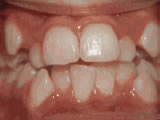 Before
Before After
AfterPatient started treatment at age 11 and wore braces for under two years. He loves his new smile.
Open bite - Front teeth don't touch
 Before
Before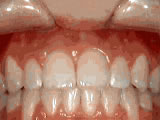 After
AfterPatient sucked her thumb as a young child. She started treatment at age 13. She had braces and a special appliance — called a crib — to retrain the tongue for approximately two years. Now she can bite the lettuce out of a sandwich.
Deep overbite - Lower front teeth bite into palate
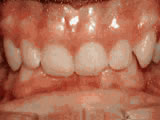 Before
Before After
AfterThis adult patient, age 25, required braces and jaw surgery to correct his severe overbite, with treatment taking two years. His problem could have been corrected without surgery if he had been treated before he was a teenager.
Missing lateral incisors
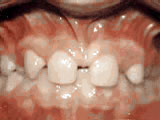 Before
Before After
AfterThis patient's lateral incisors were congenitally missing. She had braces for 20 months to move the teeth into their correct positions, then the missing teeth were replaced with bonded Maryland bridges.
Underbite - Lower front teeth in front of upper teeth
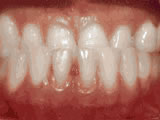 Before
Before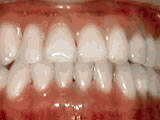 After
AfterPatient's underbite was causing her jaw joint discomfort and excessive wear patterns on her teeth. After about 30 months of treatment starting at age 32, she now finds smiling and chewing much easier.
Spacing of teeth
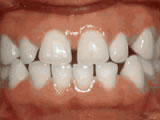 Before
Before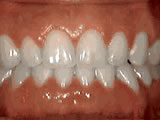 After
AfterPatient was bothered by the spaces between his teeth. Braces closed the spaces and gave him an ideal bite in 24 months. Special glued-in retainers help keep the spaces closed.
Overjet - Protruding front teeth
 Before
Before After
AfterAt age 10, patient had a big overjet with the top teeth protruding beyond the bottom. She had two phases of treatment. The first helped her jaws to grow more harmoniously, and the second aligned her teeth and bite. At age 13, she was proudly displaying her new smile.
Non-braces treatment
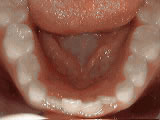 Before
Before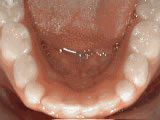 After
AfterSometimes braces are not needed to get noticeable improvements in tooth alignment. This patient was first seen at age seven for crowding of the lower permanent teeth. A procedure was performed to reduce the width of the adjacent baby teeth, and the permanent incisors aligned on their own in nine months.
Phase One
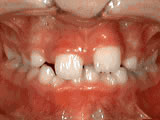 Before
Before After
AfterPatient's parents were concerned about both aesthetics and health of the erupting permanent teeth when they brought him to the orthodontist at age eight. The lower front teeth were crowded and touching the palate, and the upper front teeth were extremely displaced from their normal positions. After 12 months of Phase One treatment with an expander and partial braces, the patient's appearance and dental function were vastly improved.
